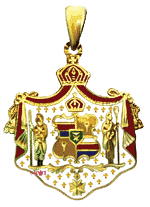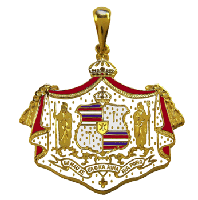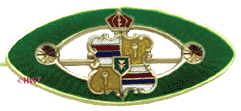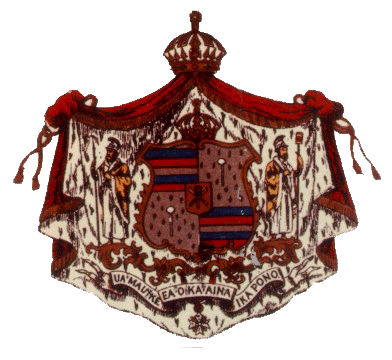HAWAIIAN COAT OF ARMS
&
UA MAU KE EA O KA AINA I KA PONO
Although adopted as our state motto in May of
1959, these immortal words were first given to the Hawaiian Kingdom
in 1843, by King Kamehameha III after the return of independence
to the Hawaiian flag from British rule. The official translation?
"The Life of the Land is Preserved in
Righteousness".
 The
Hawaii Kingdom Coat of Arms, designed by native Hawaiian Timothy
Haalilio, was adopted as the official coat-of-arms in 1845. At
the very center is the triangular flag of ancient Hawaiian Chiefs,
a symbol for kapu and place of refuge consisting of pulo'ulo'u
and crossed spears on flag. The kapu, a tapa covered
ball on a stick, was carried before a Chief as a symbol of taboo.
It was an emblem of the ultimate authority and protection for
those seeking refuge. This triangular flag, or puwalu,
represents a flag raised at sea above the sail of the chief's
canoe and symbolized the Law of the Splintered Paddle or Mamala
Hoe Kanawai decreed by Kamehameha I, circa 1782, to protect
travelers from wanton attack.
The
Hawaii Kingdom Coat of Arms, designed by native Hawaiian Timothy
Haalilio, was adopted as the official coat-of-arms in 1845. At
the very center is the triangular flag of ancient Hawaiian Chiefs,
a symbol for kapu and place of refuge consisting of pulo'ulo'u
and crossed spears on flag. The kapu, a tapa covered
ball on a stick, was carried before a Chief as a symbol of taboo.
It was an emblem of the ultimate authority and protection for
those seeking refuge. This triangular flag, or puwalu,
represents a flag raised at sea above the sail of the chief's
canoe and symbolized the Law of the Splintered Paddle or Mamala
Hoe Kanawai decreed by Kamehameha I, circa 1782, to protect
travelers from wanton attack.
The first and fourth quarters of the center seal contain white,
red, and blue stripes, alternating in color for the national banner
and believed to represent the eight largest islands in the Hawaiian
chain. The second and third quarters contain a kapu; the
tapa covered ball and stick. 
Above the royal center seal is a crown, on the
left, Hawaiian Chief Kamanawa, wearing a feather cloak and helmet,
bearing a spear, and on the right, Hawaiian Chief Kameeiamoku,
in the same dress but bearing a kahili. Both face inward
toward the Royal Seal. The two figures are thought to represent
the warrior twins instrumental in Kamehameha I endeavors to unite
the Hawaiian Islands. All this rest atop the ribbon banner containing
the mottoUA MAU KE EA O KA AINA I KA PONO. This entire
design is encased by a feathered cape background.
Several changes were made to the original design
during King Kalakaua's reign. This is when the second crown was
added to the top of the feathered cape background, which itself
was changed to an ermine cape. The two figures were faced outwards
and a cross placed under the motto.
 Although
unsure these changes were official, the new design was evidenced
in use by Kalakaua and Queen Liliuokalani by its use on Official
Palace invitations.
Although
unsure these changes were official, the new design was evidenced
in use by Kalakaua and Queen Liliuokalani by its use on Official
Palace invitations.
During the reign of King Kamehameha III and King
Kalakaua, the Royal Coat of Arms was a strong symbol to assert
the sovereignty of the crown and to reaffirm the spirit of the
Kingdom. It adorns the iron gates and fencing at the Hulihea Palace,
the Royal Mausoleum and the Iolani Palace to honor the great Kings
and Queens of the Hawaiian monarchy. Hawaii¹s most precious
heirloom jewelry. 
Centennial Jubilee Royal Crest," as it appeared
on coronation letterhead."
For more information read Coat
of Arms.
Sources: Book Hawaiian Money
By: Donald Medcalf Author
Ronald Russell Co-Author
Note: The two items shown here
are available for sale.
The Coat of Arms Pendant is: HCE-5
The Coat of Arms Pin is: HS-B1





